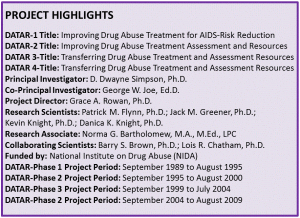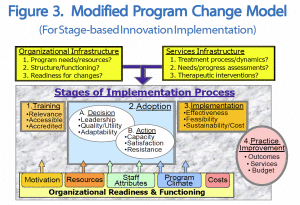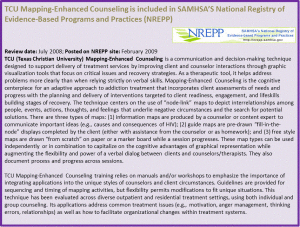
In 2004, the fourth phase of DATAR was extended with funding from a NIDA MERIT Award (for recognizing distinctive and exceptional research projects). It pursued three general goals. First were studies for testing the conceptual model of program change using a longitudinal data collection infrastructure based on TCU assessments of client and program functioning. This work emphasized the “process” of change, continuing to focus on the treatment contextual role of organizational structure and functioning. Second were studies of enhanced feedback to counselors and program leadership on client progress that can be used for monitoring performance at the agency level. A third goal was integration of the TCU interventions into clusters of treatment system modules that link together to sustain client progress through the major treatment stages. The TCU treatment interventions developed in previous phases of DATAR have been shown to be effective in improving interim performance measures representing each stage of treatment engagement process, but their integrated applications in combination with client performance assessments need further study.
Adaptive Stage-Based Intervention Planning
The collection of brief, targeted intervention modules was added to the IBR Website. Specialized module topics include anger management, communication, social networking, HIV/AIDS, cognitive distortions, contingency management, and node-link mapping. These along with other materials produced throughout the DATAR project are available for free download, clustered according to stages of client recovery needs.
Because TCU Mapping-Enhanced Counseling (MEC) is the therapeutic foundation for all TCU intervention manuals, special efforts have been made to consolidate evidence for its effectiveness and implementation procedures. This counseling technique was reviewed in 2008 by SAMHSA’s National Registry—(NREPP) and the conceptual foundations for this approach are summarized in Professional Psychology: Research and Practice (Dansereau & Simpson, 2009) [Abstract].
DATAR Research Activities
As part of the research activities, the DATAR system has undergone further development to capture data needed to address hypotheses with regard to the program change model (Simpson & Flynn, 2007). This model, portrayed in Figure 3, has several components representing strategic planning, organizational needs, and program improvement. The set of forms includes the Program Training Needs (PTN), the Organizational Readiness for Change (ORC), the Workshop Evaluation Form (WEVAL), the Workshop Assessment Follow-up Assessment (WAFU), and the Client Evaluation of Self and Treatment forms at Intake (CEST-Intake) and during treatment (CEST).
A series of studies was completed as part of a concerted effort to address implications suggested in the conceptual framework for transferring technology to clinical practice as proposed by Simpson (2002) and were published in a 2007 special issue of Journal of Substance Abuse Treatment.
Study 1 (Rowan-Szal et al.) addressed issues in Strategic Planning. It found the Program Training Needs survey (PTN) to be psychometrically sound and results of a validity analysis confirmed strong relationships between the PTN and the Organizational Readiness for Change survey (ORC). The study indicated that the PTN is useful as a strategic planning tool for guiding overall training efforts as well as in predicting the types of innovations that participating programs are likely to adopt.
Study 2 (Courtney et al.) used logistic regression analysis to examine attributes related to program-level decisions to engage in a structured process for making organizational changes. Findings showed that programs with higher needs and pressures, and those with more limited institutional resources, and poorer ratings of staff attributes and organizational climate were most likely to engage in a change strategy.
Study 3 (Greener et al.) examined the relationship of organizational functioning to program improvement. Using three measures of client engagement in treatment (rapport, satisfaction, and participation) as process outcomes in a sample of 531 clinical staff and 3,475 clients from 163 substance abuse treatment programs located in 8 states from three Addiction Technology Transfer Centers (ATTC), it was found that engagement was higher in programs with more positive indicators of organizational functioning.
Study 4 (Joe et al.) addressed the role of the counselor in workshop training utilization through their perceptions of work environments and perceived abilities. Three classes of counselors were identified through latent profile analysis using the measures of organizational climate and staff attributes. These classes were found to be related to utilization of workshop training; namely counselors who perceived themselves as being better integrated into their programs were more likely to use training than those who perceived themselves as more isolated and facing more barriers.
Study 5 (Bartholomew et al.) examined the hypothesized relationships between training and adoption decisions. Findings showed counselor ratings of their workshop trainings predicted subsequent use of those trainings. In addition, favorable post-training attitudes toward the workshop (indicators of comfort with material, interest in more training, program resources, and workshop satisfaction) were related to later adoption.
Study 6 (Simpson et al.) investigated stages in a longitudinal evaluation of the overall technology model in Figure 3. The study examined adoption of workshop training in relation to the ORC instrument and the technology transfer framework. Organizational climate, treatment program resources, and staff attributes predicted adoption. More specifically, openness to change, autonomy, opportunities for growth, and training resources were the most salient predictors. Additionally, the study integrated findings from the previous studies by showing how each fit within the evaluations model, and presented results showing that workshop training based on strategic planning was related to adoption of that training and that implementation of training was associated with program improvements in client engagement.

International Collaborations
In March 2005, the IBR hosted a prominent delegation of leaders representing treatment providers, researchers, and policy makers from England. Much like our former international work in the Veneto region of Italy in previous years, this collaboration with England’s National Treatment Agency for Substance Misuse (NTA) evolved into a significant activity. Streamlining access to drug misuse services in England is the focus of a multi-phase initiative to address the country’s need for more treatment services and improved quality of care. The emphasis was on implementation of a national treatment effectiveness strategy to improve client retention and outcomes once drug misusers enter treatment. Materials from the TCU Treatment System were adapted as part of the transfer, utilization, and evaluation of evidence-based resources and procedures for clinical practice and program management. The primary objectives, based on careful training and trial adoption of organizational and treatment program improvement strategies, helped further explorations of cross-national technology transfer of TCU treatment resources. In particular, selected materials were used to create a manual for the International Treatment Effectiveness Project (ITEP) designed to address early engagement and cognitive readiness for treatment. Subsequently, DATAR staff conducted train-the-trainers events for drug treatment counselors in the Greater Manchester region of England and London where the ITEP manual was piloted and later rolled out as part of regional training for over 1,200 counselors. In addition, the ORC and CEST surveys were administered to assess organizational functioning and treatment progress of service.
Related work was conducted as part of the Birmingham Treatment Effectiveness Initiative (BTEI), where Simpson et al. (2009) examined client functioning and treatment engagement in relation to staff attributes and organizational climate across a diverse sample of drug treatment and outreach programs. Results were interpreted using comparable data from studies of treatment programs in the U.S. Client scores on treatment participation and counseling rapport in England were associated with higher levels of motivation and psychosocial functioning, as well as to staff ratings of professional attributes and program atmosphere. The findings also indicate these relationships are rooted in personal interactions between clients and their counselor. TCU assessments of treatment structure, process, and performance across therapeutic settings and national boundaries show there is generalizability in the pattern of clinical dynamics, including the relationships between organizational functioning and quality of services.

Based on this record of progress, the NIDA International Program funded a US Distinguished International Scientist Collaborators Award (USDISCA) proposal by Simpson (with Dr. Ed Day, University of Birmingham, England, as primary collaborator) to conduct a series of leadership planning sessions and staff training seminars in the UK. The purpose was to emphasize the value of understanding (1) an adaptive treatment programming logic as represented by the TCU treatment process framework, (2) the functional and interdependent roles and applications of client assessments and intervention manuals, (3) core ingredients of recovery-oriented treatment services, their conceptual integration, and strengths and weaknesses as currently applied across England, North Wales, and Scotland, and (4) the need for formulating a strategic planning approach in adopting and implementing innovations within the treatment systems represented.
Criminal Justice System Collaborations
As part of their Offender Information System (OIS), the state of Indiana Department of Corrections (IDOC) collects records on their offenders using the Substance Abuse Intake (SAI), Client Evaluation of Self at Intake (CESI), the Client Evaluation of Self and Treatment (CEST), and the Criminal Thinking Scales (CTS). With offender records also providing information on criminal and medical history, treatment session attendance, urine tests, requested time cuts, time in treatment, compliance with treatment plan activities, and program completion, collaborative studies with the Indiana Department of Corrections focused on longitudinal evaluations of client performance and engagement indicators across different CJ treatment settings and populations.
Through secondary data analysis, the IBR in collaboration with the IDOC, completed two studies addressing engagement in prison-based treatments, perceptions of care received, and changes in psychosocial functioning and criminal thinking errors. In the first, prison-based interventions for female inmates with a history of methamphetamine use were found to be effective in improving psychosocial functioning and criminal thinking. In a sample of 359 female offenders, participants in both the modified therapeutic community designed for nonviolent offenders and the traditional outpatient treatment were found to improve on self esteem, depression, anxiety, decision making, hostility, and risk taking, as well as on criminal thinking errors (Rowan-Szal et al., 2009).
In the second study (Joe et al., 2009), psychosocial functioning and criminal thinking of methamphetamine-using male inmates were examined before and after their completion of primary treatment in three in-prison drug treatment programs (one “outpatient” and two different modified TCs). The sample consisted of 2,026 adult male inmates in 30 treatment sites. Significant improvements were found for all three treatments, but participants in the two modified TCs showed significantly better progress than did those in the outpatient treatment housed among the general prison population. Higher psychosocial functioning and lower criminal thinking orientation predicted stronger therapeutic engagement, and treatment engagement level was found to mediate during-treatment improvement and initial criminal thinking.
Selected Publications
Dansereau, D. F., & Simpson, D. D. (2009). A picture is worth a thousand words: The case for graphic representations. Professional Psychology: Research & Practice, 40(1), 104-110. [Abstract]
Flynn, P. M., & Simpson, D. D. (2009). Adoption and implementation of evidence-based treatment. In P. M. Miller (Ed.), Evidence-based addiction treatment (pp. 419-437). San Diego, CA: Elsevier.
Joe, G. W., Simpson, D. D., & Rowan-Szal, G. A. (2009). Interaction of counseling rapport and topics discussed in sessions with methadone treatment clients. Substance Use & Misuse, 44(1),
3-17. [Abstract]
Rowan-Szal, G. A., Joe, G. W., Simpson, D. D., Greener, J. M., & Vance, J. (2009). During-treatment outcomes among female methamphetamine-using offenders in prison-based treatments. Journal of Offender Rehabilitation, 48(5), 388-401. PMCID: PMC2731425 [Abstract]
Simpson, D. D. (2009). Organizational readiness for stage-based dynamics of innovation implementation. Research on Social Work Practice, 19(5), 541-551. [Abstract]
Simpson, D. D., Rowan-Szal, G. A., Joe, G. W., Best, D., Day, E., & Campbell, A. (2009). Relating counselor attributes to client engagement in England. Journal of Substance Abuse Treatment, 36(3), 313-320. PMCID: PMC2697954 [Abstract]
Simpson, D. D., & Flynn, P. M. (Guest Eds.). (2007). Organizational Readiness for Change (Special Issue). Journal of Substance Abuse Treatment, 33(2), 111-209.